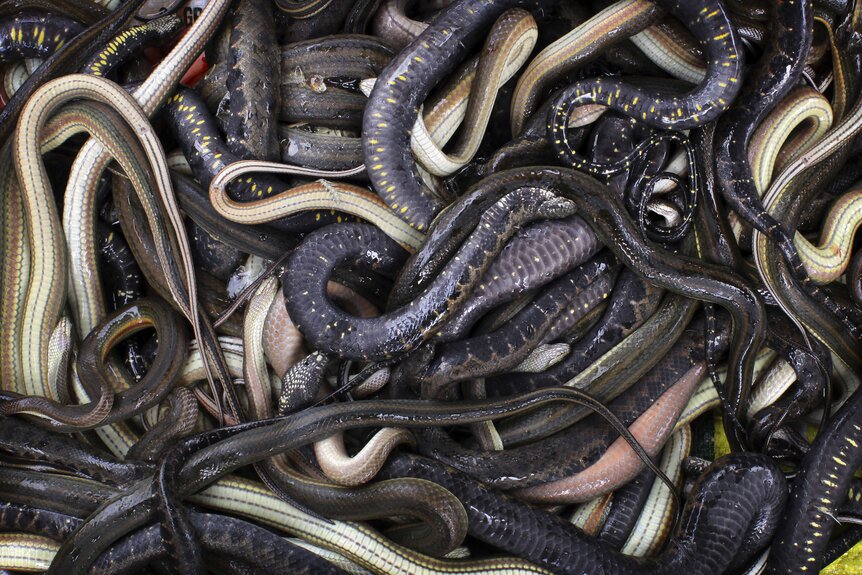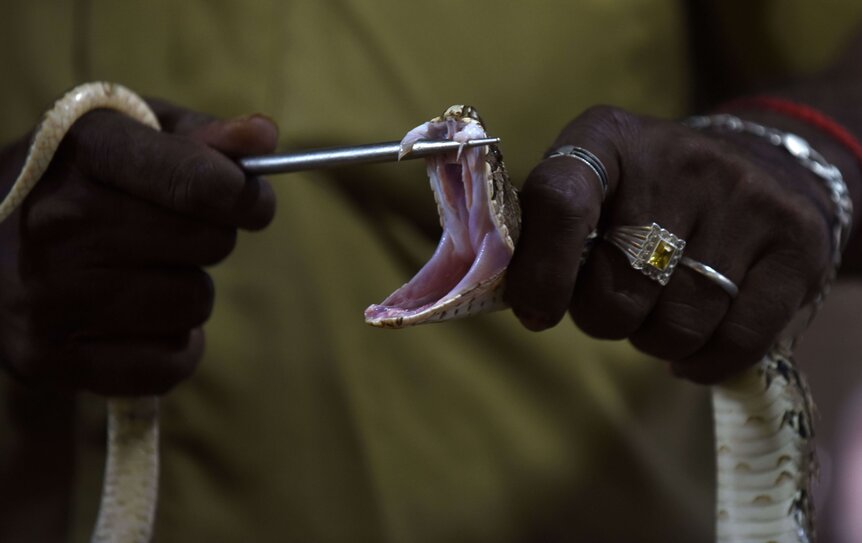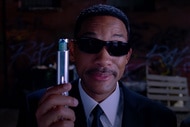Would snakes on a plane really behave like Snakes on a Plane? The science behind the fiction

Snakes on a Plane, due to some combination of ridiculousness and hype, managed to achieve cult status even before it hit theaters. The premise — that there are snakes on a plane — was knowingly absurd, and Samuel L. Jackson brought just the right amount of seriousness and self-knowing silliness to the role.
Your mileage may vary on how much Snakes on a Plane lived up to expectations, but it's hard, even now, not to smile at the absurd premise. The question we have, 15 years after those slithery reptiles took flight and went berserk, is just how absurd is that premise, really?
SNAKES IN A GROUP
In the film, a gangster unleashes a vast collection of dangerous snakes inside an airplane in an attempt to kill a witness who is going to testify against him. In an effort to ensure the snakes are at maximum aggression, the passenger’s leis are sprayed with a pheromone intended to make the snakes even more dangerous than they might usually be.
It’s worth mentioning that pheromones don’t work that way. They are discreet chemical compounds specific to a species, as discussed in a previous article, and can’t be designed to work across a complex group of disparate species. If you wanted to make snakes react to pheromones, all of the snakes in the cargo bay would have to be the same species. While this still wouldn’t be ideal, from a passenger's perspective, it also wouldn’t be the bloodbath we see in the movie. The rest of this article will look at some of the finer points of snake behavior, but the bottom line is that there's no way you could get a bunch of different snakes to go on a rampage inside a plane just by spraying some pheromones.
Despite being billed to us as solitary hunters, living out their lives alone in nature’s badlands, many snake species do pretty well in group. You’ve probably seen a number of the same species in the same enclosure at pet stores or zoos. In nature, some snakes hang out in massive gatherings to mate or socialize.
Studies have found that snakes are more social than we previously supposed and even form social bonds which might be called friendships. A study published in the journal Behavioral Ecology and Sociobiology tracked the behavior of 40 garter snakes in a 3-foot by 3-foot enclosure. Researchers limited the number of hiding places, requiring the snakes to shack up together. That the animals formed groups wasn’t surprising, but the way they did was.
At intervals, the snakes were removed from the enclosure so it could be cleaned. When they were returned, they were placed at different locations than where they’d been found. Researchers discovered the snakes would return to their previous groupings, indicating a preference for some of their peers over others. Even in snake enclosures, there’s a cool kid’s table.
More importantly for the movie’s purposes, some snakes have been seen coordinating their efforts to hunt in groups. A study published in the journal Animal Behavior and Cognition examined Cuban boas living in bat caves. Vladimir Dinets, a research assistant professor of psychology at the University of Tennessee, observed boas hanging from the ceiling of the cave entrance. When more than one snake was present, they staggered their locations until the bats couldn’t enter the cave without being in striking distance.
These coordinated efforts resulted in quicker and more frequent meals. Any time the snakes worked together; they were successful. A solitary snake took longer to catch a meal and sometimes went hungry. But, what about different types of snakes sharing the same territory?
There isn’t much literature about different species of snakes living together. It is, by and large, discouraged among hobbyists and professionals and isn’t something often seen in nature. Snakes do, for the most part, keep to themselves. The real trouble for the passengers of the titular plane is the close quarters. Snakes that might typically keep to themselves or try to hide will inevitably strike when cornered — and being trapped in a metal tube with dozens of panicking people is a good way to feel cornered. The snakes themselves aren’t necessarily inherently dangerous, but the circumstances are.
So, what’s the prognosis for the passengers once bitten? Well, it depends, but it's probably not good.
HOW DEADLY ARE SNAKES, REALLY?
There were a number of species present on flight 121, most of them replaced either with non-venomous stand-ins or realized via CGI. An encounter with one of the real things, especially in flight, might result in a pretty bad day, especially if you're over the ocean, hours away from civilization.
Coral snakes, for instance, have incredibly strong venom, second only to the black mamba, but they are small and have a poor venom delivery system. No humans have died from a coral snake bite in more than 50 years, due to the availability of antivenin. If a bite is left untreated, it can lead to cardiac arrest, so treatment is prudent. The good news is that it can take several hours for symptoms to set in. An airborne bite from a coral snake would be unpleasant, but provided you could land and get to a hospital; it wouldn’t pose a serious risk.
However, The inland taipan, one of the other snakes showcased in the movie, has an incredibly deadly bite. According to experts, bite victims need immediate attention and antivenin administered as soon as possible — like within the first hour. Even then the recovery process is long and arduous. On the bright side, like many snakes, the taipan avoids people and only bites as a last resort. Most bites happen when people attempt to handle the snakes, not as a result of a chance encounter.
Cobras are likewise deadly. Their venom is not the most powerful but they deliver a lot of it, they are even capable of spitting venom into a victim’s eyes causing pain and blindness. The venom causes tissue necrosis at the bite site. More importantly, it inhibits nerve transmission around the diaphragm, causing respiratory paralysis.
So, while Snakes on a Plane's nightmare scenario is absurd, you should still try not to get trapped on a plane with venomous snakes. But, if you do, try to be on the same plane as Samuel L. Jackson.






























